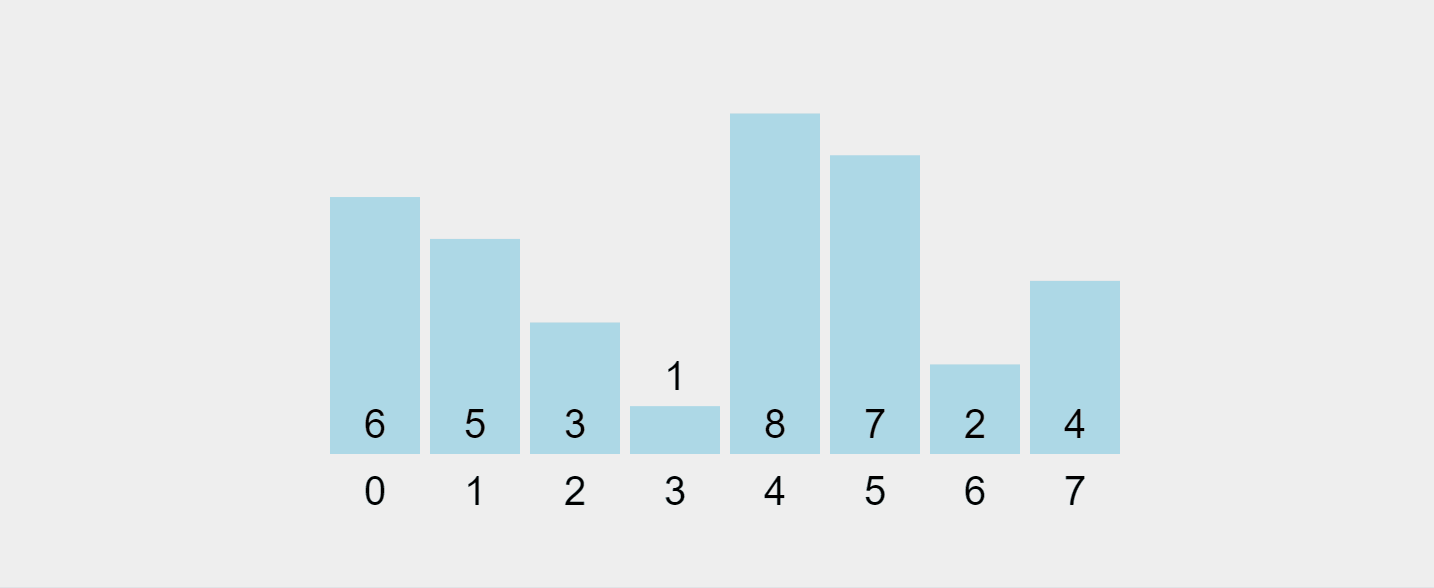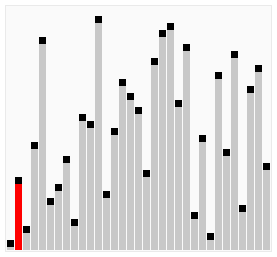버블 정렬은 컴퓨터 과학에서 가장 간단한 정렬 알고리즘 중 하나입니다. 반복할 때마다 작은 요소가 목록의 맨 위로 "버블링"되는 방식에서 이름이 붙여진 이 도구는 정렬 알고리즘의 기본을 가르치기 위한 훌륭한 도구입니다. 대규모 데이터세트에 가장 효율적이지는 않지만 단순성은 정렬 알고리즘의 작동 방식을 이해하는 데 훌륭한 출발점이 됩니다.
버블 정렬은 목록을 반복적으로 살펴보고, 인접한 요소를 비교하고, 순서가 잘못된 경우 교체하는 방식으로 작동합니다. 더 이상 교체가 필요하지 않을 때까지 이 프로세스가 반복되어 목록이 정렬되었음을 나타냅니다.
다음은 단계별 분석입니다.
이 과정을 시각화해 보겠습니다.

https://visualgo.net/en/sorting에서 녹화한 gif
각각 최적화 수준이 증가하는 JavaScript의 세 가지 버블 정렬 구현을 살펴보겠습니다.
function bubbleSort(list) {
// Outer loop: iterate through the entire list
for (let i = 0; i < list.length - 1; i++) {
// Inner loop: compare adjacent elements
for (let j = 0; j < list.length - 1; j++) {
// If the current element is greater than the next one
if (list[j] > list[j + 1]) {
// Swap the elements using destructuring assignment
[list[j], list[j + 1]] = [list[j + 1], list[j]];
}
}
}
// Return the sorted list
return list;
}
이 기본 구현은 중첩 루프를 사용하여 인접한 요소를 비교하고 교환합니다. 외부 루프는 배열을 통해 충분한 패스를 수행하는 반면 내부 루프는 비교 및 교체를 수행합니다.
function bubbleSort(list) {
// Outer loop: iterate through the entire list
for (let i = 0; i < list.length - 1; i++) {
// Flag to check if any swaps occurred in this pass
let swapped = false;
// Inner loop: compare adjacent elements
for (let j = 0; j < list.length - 1; j++) {
// If the current element is greater than the next one
if (list[j] > list[j + 1]) {
// Swap the elements using destructuring assignment
[list[j], list[j + 1]] = [list[j + 1], list[j]];
// Set the swapped flag to true
swapped = true;
}
}
// If no swaps occurred in this pass, the list is sorted
if (!swapped) {
break; // Exit the outer loop early
}
}
// Return the sorted list
return list;
}
이 버전에는 패스에서 스왑이 이루어졌는지 확인하기 위한 스왑 플래그가 도입되었습니다. 스왑이 발생하지 않으면 목록이 이미 정렬되어 있으므로 루프에서 조기에 벗어날 수 있습니다.
function bubbleSort(list) {
// Outer loop: iterate through the entire list
for (let i = 0; i < list.length - 1; i++) {
// Flag to check if any swaps occurred in this pass
let swapped = false;
// Inner loop: compare adjacent elements
// Note: We reduce the upper bound by i in each pass
for (let j = 0; j < list.length - 1 - i; j++) {
// If the current element is greater than the next one
if (list[j] > list[j + 1]) {
// Swap the elements using destructuring assignment
[list[j], list[j + 1]] = [list[j + 1], list[j]];
// Set the swapped flag to true
swapped = true;
}
}
// If no swaps occurred in this pass, the list is sorted
if (!swapped) {
break; // Exit the outer loop early
}
}
// Return the sorted list
return list;
}
이 최종 최적화는 각 패스에서 내부 루프의 범위를 i만큼 줄입니다. 이는 각 패스 후에 정렬되지 않은 가장 큰 요소가 배열 끝의 올바른 위치로 "버블링"되기 때문입니다.
Bubble Sort의 성능 특성은 다음과 같습니다.
시간 복잡성:
공간 복잡도: O(1) - 버블 정렬은 일정한 양의 추가 메모리만 필요로 하는 내부 정렬 알고리즘입니다.
빠른 정렬(평균 O(n log n)) 또는 병합 정렬(O(n log n))과 같은 고급 알고리즘과 비교할 때 Bubble Sort의 2차 시간 복잡도는 대규모 데이터 세트에 비효율적입니다.
장점:
단점:
칵테일 셰이크 정렬 또는 양방향 버블 정렬이라고도 하는 칵테일 정렬은 버블 정렬의 향상된 버전입니다. 목록을 양방향으로 탐색하여 요소를 올바른 위치로 보다 효율적으로 이동하는 데 도움이 됩니다.
Cocktail Sort is particularly useful in cases where the array has elements that are initially large at the beginning and small at the end, as it can reduce the total number of passes needed compared to traditional Bubble Sort.
Here's a visualization of Cocktail Sort:

Visual from Wikipedia: https://en.wikipedia.org/wiki/Cocktail_shaker_sort
function cocktailSort(list) {
let swapped;
// The do...while loop ensures the sorting continues until no swaps are needed
do {
// Reset the swapped flag at the beginning of each complete iteration
swapped = false;
// First pass: left to right (like standard bubble sort)
for (let i = 0; i < list.length - 1; i++) {
// If the current element is greater than the next, swap them
if (list[i] > list[i + 1]) {
[list[i], list[i + 1]] = [list[i + 1], list[i]];
// Mark that a swap occurred
swapped = true;
}
}
// If no swaps occurred in the first pass, the array is sorted
if (!swapped) {
break; // Exit the do...while loop early
}
// Reset the swapped flag for the second pass
swapped = false;
// Second pass: right to left (this is what makes it "cocktail" sort)
for (let i = list.length - 2; i >= 0; i--) {
// If the current element is greater than the next, swap them
if (list[i] > list[i + 1]) {
[list[i], list[i + 1]] = [list[i + 1], list[i]];
// Mark that a swap occurred
swapped = true;
}
}
// The loop will continue if any swaps occurred in either pass
} while (swapped);
// Return the sorted list
return list;
}
This implementation alternates between forward and backward passes through the list, potentially reducing the number of iterations needed to sort the array.
While Bubble Sort isn't typically used in production environments for large-scale applications, it can still find use in certain scenarios:
Bubble Sort, despite its inefficiencies with large datasets, offers valuable insights into the world of sorting algorithms and algorithm analysis. Its straightforward approach makes it an excellent teaching tool for beginners in computer science.
Key takeaways are:
While you're unlikely to use Bubble Sort in production code for large-scale applications, the principles behind it are fundamental to many algorithms. The process of optimizing Bubble Sort teaches valuable lessons about algorithm improvement, serving as a stepping stone to more advanced computational problem-solving.
When it comes to algorithms, there's rarely a one-size-fits-all solution. The best algorithm for a given task depends on the specific requirements, constraints, and characteristics of your data. Bubble Sort, with all its limitations, still has its place in this diverse algorithmic ecosystem.
위 내용은 Javascript를 사용한 알고리즘을 통한 항해 - 버블 정렬의 상세 내용입니다. 자세한 내용은 PHP 중국어 웹사이트의 기타 관련 기사를 참조하세요!